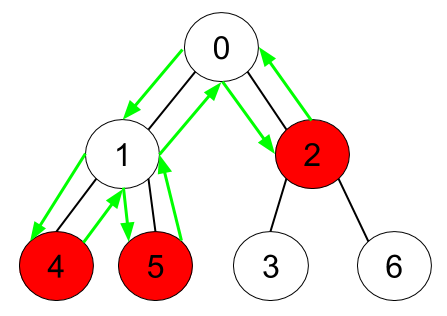LeetCode-in-Java
1443. Minimum Time to Collect All Apples in a Tree
Medium
Given an undirected tree consisting of n vertices numbered from 0 to n-1, which has some apples in their vertices. You spend 1 second to walk over one edge of the tree. Return the minimum time in seconds you have to spend to collect all apples in the tree, starting at vertex 0 and coming back to this vertex.
The edges of the undirected tree are given in the array edges, where edges[i] = [ai, bi] means that exists an edge connecting the vertices ai and bi. Additionally, there is a boolean array hasApple, where hasApple[i] = true means that vertex i has an apple; otherwise, it does not have any apple.
Example 1:

Input: n = 7, edges = [[0,1],[0,2],[1,4],[1,5],[2,3],[2,6]], hasApple = [false,false,true,false,true,true,false]
Output: 8
Explanation: The figure above represents the given tree where red vertices have an apple. One optimal path to collect all apples is shown by the green arrows.
Example 2:

Input: n = 7, edges = [[0,1],[0,2],[1,4],[1,5],[2,3],[2,6]], hasApple = [false,false,true,false,false,true,false]
Output: 6
Explanation: The figure above represents the given tree where red vertices have an apple. One optimal path to collect all apples is shown by the green arrows.
Example 3:
Input: n = 7, edges = [[0,1],[0,2],[1,4],[1,5],[2,3],[2,6]], hasApple = [false,false,false,false,false,false,false]
Output: 0
Constraints:
1 <= n <= 105edges.length == n - 1edges[i].length == 20 <= ai < bi <= n - 1fromi < toihasApple.length == n
Solution
import java.util.ArrayList;
import java.util.Collections;
import java.util.HashMap;
import java.util.HashSet;
import java.util.List;
import java.util.Map;
import java.util.Set;
@SuppressWarnings("java:S1172")
public class Solution {
public int minTime(int n, int[][] edges, List<Boolean> hasApple) {
Set<Integer> visited = new HashSet<>();
Map<Integer, List<Integer>> graph = new HashMap<>();
for (int[] edge : edges) {
int vertexA = edge[0];
int vertexB = edge[1];
graph.computeIfAbsent(vertexA, key -> new ArrayList<>()).add(vertexB);
graph.computeIfAbsent(vertexB, key -> new ArrayList<>()).add(vertexA);
}
visited.add(0);
int steps = helper(graph, hasApple, 0, visited);
return steps > 0 ? steps - 2 : 0;
}
private int helper(
Map<Integer, List<Integer>> graph,
List<Boolean> hasApple,
int node,
Set<Integer> visited) {
int steps = 0;
for (int child : graph.getOrDefault(node, Collections.emptyList())) {
if (visited.contains(child)) {
continue;
} else {
visited.add(child);
}
steps += helper(graph, hasApple, child, visited);
}
if (steps > 0) {
return steps + 2;
} else if (Boolean.TRUE.equals(hasApple.get(node))) {
return 2;
} else {
return 0;
}
}
}

